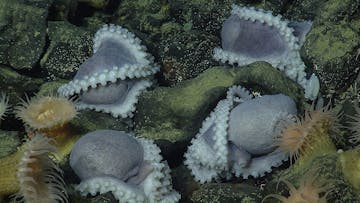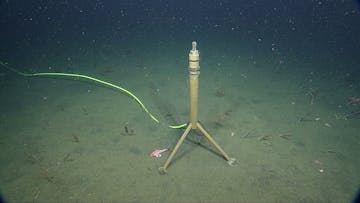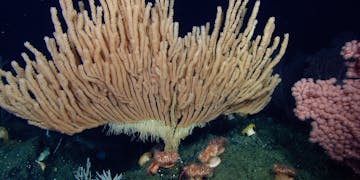Whether it’s discovering diverse life at a seamount in Monterey Bay, measuring microplastics in marine food webs, or applying artificial intelligence to understand our changing ocean soundscape, the long-standing partnership between MBARI and NOAA’s Monterey Bay National Marine Sanctuary (MBNMS) provides a roadmap for how to successfully combine ocean science and ocean stewardship. MBARI ocean exploration—driven by the desire of MBARI scientists and engineers to better understand our ocean—has led to the discovery of key MBNMS management issues. In each example below, the research findings are being applied far beyond Monterey Bay.
Davidson Seamount

Part of the allure of deep-sea exploration is that, if you are lucky, you might discover a magical place—like a seamount. Seamounts are undersea mountains that are often remnants of former volcanoes. They are like oases in a desert, providing food and shelter for a wide variety of stunning creatures. Davidson Seamount—42 kilometers (26 miles) long and 12.8 kilometers (eight miles) wide—rises an impressive 2,400 meters (1.5 miles) up from the ocean floor, yet it is still a long way—1,256 meters (three-quarters of a mile)—beneath the sea surface and is completely invisible when looking down from above.
Located 120 kilometers (75 miles) southwest of Monterey, Davidson Seamount was first mapped in 1933. Five years later, it became the first geographic feature to be characterized as a “seamount.” Davidson Seamount last erupted as an undersea volcano approximately 9.8 million years ago. MBARI, in its quest to better map the seafloor, first created high-resolution maps of Davidson Seamount in 1998.
Working with his colleague Andrew DeVogelaere from the MBNMS, MBARI Scientist Jim Barry captured the first video images of Davidson Seamount in 2000. They were delighted and intrigued to discover an amazing underwater world rich with exotic sponges and tall stands of ancient coral forests where some individual corals can reach more than three meters (10 feet) high. Davidson Seamount is truly an oasis where deep-sea corals and sponges grow bigger and more abundantly than in other places.
Recently, a magnificent “Octopus Garden” was discovered there. Thousands of brooding females use the base of the seamount as a nursery to keep their offspring safe from predators. Nesting sites at Davidson Seamount are associated with warm-water seeps, yet another important discovery.

A close-up of the Octopus Garden showing aggregations of octopus (Muusoctopus robustus). Nearly all are females guarding their nests.
Scientists from MBARI, the Sanctuary, and Monterey Bay Aquarium continue to return to Davidson Seamount in a partnership to further characterize the corals, sponges, and other animals that are part of this unique habitat. The Davidson Seamount Taxonomic Guide generated through this partnership documents 18 species new to science and is used regularly on other seamount and deep-sea expeditions.
Data from Davidson Seamount are being used to develop new ways for sharing information on ecosystem health. During a 2019 mission, scientists discovered a sunken whale carcass being scavenged by an assortment of deep-sea animals ranging from sleeper sharks to two recently-discovered species of Osedax, bone-eating worms.
Researchers are also using data from the seamount to understand the impacts of climate change. Deep waters off the California coast are naturally more acidic than other ocean areas, so researchers are using Davidson Seamount as a window to observe the future impacts of ocean acidification on deep-sea corals throughout the world and to develop best practices for coral restoration. Preliminary research has also found that microplastics are present at Davidson Seamount, implying a broader need to address this critical issue affecting ocean health.
What began as a routine mission aboard MBARI research vessel Western Flyer as part of an ongoing study of the geology, chemistry, and biology of seamounts led to Davidson Seamount becoming a part of the Sanctuary. Davidson Seamount was added to the MBNMS in 2008 and is now considered one of the best-studied and best-protected seamounts in the world. More than 30,000 seamounts are known in the Pacific Ocean alone, but fewer than 0.1 percent of the world’s seamounts have been explored and relatively few have been protected. The story of Davidson Seamount—its exploration, study, and conservation—offers a model for future safeguarding of offshore marine protected areas and seamounts.
Lost shipping container
Thousands of shipping containers are lost from cargo vessels each year. Many of these containers eventually sink to the deep seafloor. In 2004, researchers at MBARI discovered a lost shipping container almost 1,300 meters (4,265 feet) below the surface in the Monterey Bay National Marine Sanctuary. In the first-ever survey of its kind, researchers from MBARI and the Sanctuary described how deep-sea animal communities on and around the container differed from those in surrounding areas.
In the first-ever survey of its kind, researchers from MBARI and the MBNMS described how deep-sea animal communities on and around the container differed from those in surrounding areas.
The study showed that the container caused shifts in animal communities through a variety of processes. Its physical presence provided: 1) a hard surface that sessile (attached) animals colonized; 2) a physical obstacle that affected local bottom currents; 3) a high spot on the seafloor that attracted predators; and 4) a possible source of toxic materials.
This collaborative research project has already helped government agencies formulate standards for how containers are weighed, stacked,
and lashed down. It has also spurred interest from both governmental agencies and the shipping industry in finding a way to track the number of containers lost at sea each year. The US Coast Guard mentioned this research in the background material for a proposed lashing rule,
showing how MBARI’s deep-sea exploration can have clear societal impact.
What began as a routine mission aboard MBARI research vessel R/V Western Flyer as part of an ongoing study of the geology, chemistry, and biology of seamounts, led to Davidson Seamount becoming a part of the Sanctuary.
The ocean soundscape

In 2015, MBARI scientists and engineers placed a hydrophone (an underwater microphone) on the Monterey Accelerated Research System (MARS), MBARI’s underwater observatory, resting 900 meters (2,953 feet) underwater. MARS is comparable to a big, underwater, multi-pronged power outlet with a 32-mile long extension cord reaching back to shore that allows scientists to plug in different monitoring devices and transmit all the data collected by these devices back to MBARI’s labs onshore.
The hydrophone records sound within and outside the range of human hearing. The MARS hydrophone is the only one of its kind in Monterey Bay and, in just four years, it has made MBARI a premier center for soundscape research. Because it records continuously—24 hours a day, seven days a week—the hydrophone allows scientists to get a rare glimpse of the behaviors and interactions of many different creatures over time. For example, the hydrophone has shown that most humpback whale songs occur between November and January when they are migrating to warmer waters.
One of the unexpected findings of this research was the detonation of seal bombs—small explosives used to scare marine mammals away from fishing grounds. The hydrophone has recorded as many as 335 seal bomb explosions in one day. MBARI shared this surprising finding with MBNMS staff, leading to a NOAA-wide effort to understand and protect acoustic habitat in the Sanctuary. MBARI is now working closely with NOAA staff to advance our understanding of the impact of human-caused sounds. Seal bombs are not just a local problem, which means this research has a much broader application.

The MARS hydrophone sits on the seafloor at Smooth Ridge, just outside of Monterey Bay. It is connected to the MARS cabled ocean observatory, which supplies power and a high-speed data connection to shore.
Additionally, the ocean soundscape research presents a unique outreach opportunity. MBARI partnered with NOAA to launch an exhibit at the Sanctuary Exploration Center in Santa Cruz, California, in April 2019. The exhibit shares the sounds of the sea with visitors, showcasing 10 different ocean sounds—including rain, earthquakes, dolphins, and whales—all courtesy of MBARI’s underwater microphone.
The challenges facing the ocean science community are too big for any single institution to tackle alone. Less than five percent of the ocean has been explored, even as we race to solve existential threats like overfishing, pollution, and climate change. It is obvious that ocean exploration and sustainable resource management are equally urgent. But these examples show that they often go hand in hand. Strategic partnerships can provide an effective and efficient way to advance on both fronts. MBARI’s long-standing partnership with NOAA’s Monterey Bay National Marine Sanctuary serves as a powerful example of how this is being done.
